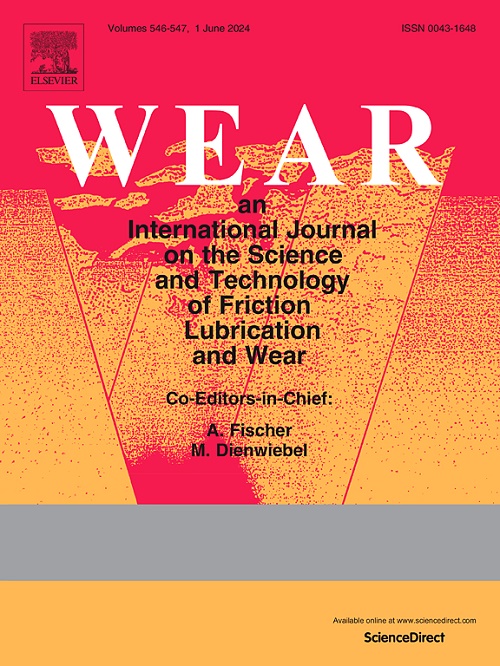聚四氟乙烯-凯夫拉纤维衬里正交摩擦连续磨损的模拟和实验验证
IF 5.3
1区 工程技术
Q1 ENGINEERING, MECHANICAL
引用次数: 0
摘要
可定制且免维护的编织物衬里在自润滑球面轴承中有着广泛的应用。然而,由于其正交各向异性和非均质特性,其摩擦和磨损行为非常复杂。目前,平均性能测试主要基于长期的宏观磨损实验。然而,内衬中的介观应力和压力分布等不可观测参数是实验探索磨损源和磨损机理的瓶颈。因此,本文提出了一种创新策略,用于模拟非均质衬里中的正交摩擦和连续磨损。这种方法有可能克服实验限制,大大加快衬垫设计和成本效益验证。第一步是建立一个基于网格体素的衬垫平面模型,在磨损过程中保持拓扑关系。这是通过引入圆形体素网格和空间变换方法实现的。根据正交摩擦和磨损假设,分别建立了正交摩擦和磨损的构成模型。利用 CETR UMT-3 摩擦磨损试验机,选择 GCr15 作为反面材料,采用针盘磨损法对 PTFE 和 Kevlar 纤维进行滑动测试,并拟合出所需的磨损构成参数。此外,还推导出了总磨损的增量方程。引入了元素磨损融合策略。通过这种方法,开发出了内衬连续磨损算法,并随后建立了基于体素的有限元模型,该模型具有圆形体素网格的连续磨损能力。这种方法超越了实验方法,可以确定衬垫的中观接触压力、应力分布以及接触材料成分模式的变化。实验验证了平均宏观磨损预测的准确性。该方法有望在轴承设计中得到实际应用。本文章由计算机程序翻译,如有差异,请以英文原文为准。
Simulation and experimental verification of the orthogonal friction continuous wear of PTFE-Kevlar fabric liner
Woven fabric liners, which are customizable and maintenance-free, have extensive applications in self-lubricating spherical bearings. However, owing to the orthogonal anisotropy and non-homogeneous characteristics, their frictional and wear behaviors are complex. Currently, average performance testing is primarily based on long-term macroscopic wear experiments. However, unobservable parameters such as mesoscopic stress and pressure distribution in liners are bottlenecks in the experimental exploration of wear sources and mechanisms. Therefore, an innovative strategy for modeling orthogonal friction and continuous wear in non-homogeneous liners is presented. This approach has the potential to overcome experimental limitations and significantly expedite liner design and cost-effective validation. The initial step involves establishing a mesoscopic voxel-based planar model of the liner that maintains the topological relationship during wear processes. This is achieved by introducing a circular voxel mesh and spatial transformation methods. Based on orthogonal friction and wear assumptions, separate constitutive models for orthogonal friction and wear are developed. Using the CETR UMT-3 friction and wear testing machine, GCr15 is selected as the counterface material, the pin disc wear method is adopted to conduct sliding test on PTFE and Kevlar fibers, and the required wear constitutive parameters are fitted. Furthermore, incremental equations for the total wear are derived. An element wear fusion strategy is introduced. This approach leads to the development of a continuous wear algorithm for liners and subsequently to the establishment of a voxel-based finite element model with continuous wear capability in the form of a circular voxel grid. This method transcends experimental methods and allows for the determination of the mesoscopic contact pressure, stress distribution, and variations in the contact material composition patterns of liner. The accuracy of the average macroscopic wear prediction is validated experimentally. This method has the potential for practical applications in bearing design.
求助全文
通过发布文献求助,成功后即可免费获取论文全文。
去求助
来源期刊

Wear
工程技术-材料科学:综合
CiteScore
8.80
自引率
8.00%
发文量
280
审稿时长
47 days
期刊介绍:
Wear journal is dedicated to the advancement of basic and applied knowledge concerning the nature of wear of materials. Broadly, topics of interest range from development of fundamental understanding of the mechanisms of wear to innovative solutions to practical engineering problems. Authors of experimental studies are expected to comment on the repeatability of the data, and whenever possible, conduct multiple measurements under similar testing conditions. Further, Wear embraces the highest standards of professional ethics, and the detection of matching content, either in written or graphical form, from other publications by the current authors or by others, may result in rejection.
 求助内容:
求助内容: 应助结果提醒方式:
应助结果提醒方式:


